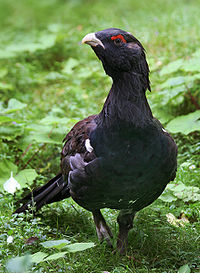
Photo from wikipedia
Gallinaceous birds, including Western Capercaillies (Tetrao urogallus) and Black Grouse (Tetrao tetrix), are kept in aviaries and reintroduced to natural habitats as a part of ongoing measures to protect these… Click to show full abstract
Gallinaceous birds, including Western Capercaillies (Tetrao urogallus) and Black Grouse (Tetrao tetrix), are kept in aviaries and reintroduced to natural habitats as a part of ongoing measures to protect these endangered species. Although parasitic loads can immensely affect reintroduction success of these species, little is known about how the infestation level varies in birds reared with different methods. The aim of this study was to determine the prevalence of endoparasites in fecal samples collected from Galliformes kept in various types of aviaries and transported to reintroduction sites. Most parasitic infections in the examined birds were caused by protozoa of the genus Eimeria, including Eimeria lyruri and Eimeria procera in Western Capercaillies, and E. lyruri, Eimeria nadsoni, and Eimeria tetricis in Black Grouse, which also hosted nematodes of the Capillaria spp. and Ascaridia galli. The prevalence of parasites varied across different types of aviaries. In permanent aviaries, Eimeria spp. was detected in 36% and 35% of the fecal samples collected from Western Capercaillies and Black Grouse, whereas Capillaria spp. were identified in 41% and 69% of the samples, respectively. The prevalence of the identified parasites increased in permanent aviaries on the second sampling date. In contrast, birds kept in seminatural free-flight aviaries in line with the "born to be free" rearing method had a lower prevalence of these parasites. Galliformes housed in seminatural aviaries may be better prepared for reintroduction to their natural habitats.
Journal Title: Journal of wildlife diseases
Year Published: 2021
Link to full text (if available)
Share on Social Media: Sign Up to like & get
recommendations!